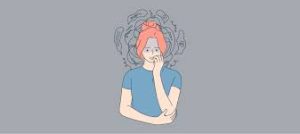 Neurosis is used to describe mental disorders caused by past anxiety, often that has been repressed, no longer used in psychiatric diagnosis.
Neurosis is used to describe mental disorders caused by past anxiety, often that has been repressed, no longer used in psychiatric diagnosis.
Neurosis is a term used in psychology to describe a mental disorder characterized by distressing symptoms that are not caused by any apparent physical or neurological dysfunction or any severe break with reality.
Neurosis is distinguished from psychosis, which refers to a loss of touch with reality.
Neuroticism, refers to a personality trait of being prone to anxiousness and mental collapse.
Conditions in the category include: Anxiety reaction Dissociative reaction Conversion reaction Phobic reaction Obsessive compulsive reaction Depressive reaction Psychoneurotic reaction
Neurotic disorders involve significant emotional distress and impaired functioning but do not involve hallucinations, delusions, or a loss of touch with reality, which are typical symptoms of psychotic disorders.
Some key characteristics of neurosis include:
1. Anxiety disorders: Neurosis often manifests as excessive anxiety, worry, or fear that is disproportionate to the actual situation or threat.
2. Obsessive-compulsive behaviors: Individuals with neurosis may experience obsessive thoughts or engage in compulsive behaviors as a way to alleviate anxiety.
3. Phobias: Neurotic individuals may have irrational and persistent fears or phobias related to specific objects or situations.
4. Somatic symptoms: Neurosis can also involve physical symptoms such as headaches, fatigue, or gastrointestinal problems that are not fully explained by a medical condition.
5. Emotional disturbances: Neurotic disorders are often accompanied by emotional disturbances such as depression, irritability, or mood swings.
6. Impaired functioning: The symptoms of neurosis can interfere with an individual’s ability to function effectively in various areas of life, such as work, relationships, or social situations.
The term neurosis is not as widely used in modern psychiatric diagnostic systems as before.
Today there is an effort to use more specific diagnostic categories, such as anxiety disorders, obsessive-compulsive disorder (OCD), or somatic symptom disorders, to describe the specific symptoms and patterns of behavior associated with neurotic conditions.
Benzodiazepines are a class of highly addictive sedative drugs that reduce anxiety by depressing function in certain parts of the brain.
According to the anxiety concept of the term, there were many different neuroses, including:
obsessive–compulsive disorder (OCD) obsessive–compulsive personality disorder impulse control disorder anxiety disorder histrionic personality disorder dissociative disorder a great variety of phobias
The symptoms of neurosis may involve: anxiety, sadness or depression, anger, irritability, mental confusion, low sense of self-worth, phobic avoidance, vigilance, impulsive and compulsive acts, lethargy, cognitive problems such as unpleasant or disturbing thoughts, repetition of thoughts and obsession, habitual fantasizing, negativity and cynicism.
Interpersonally, neurosis involves dependency, aggressiveness, perfectionism, schizoid isolation, and socio-culturally inappropriate behaviors.
Theoretically neuroses may be rooted in ego defense mechanisms, as defense mechanisms are a normal way of developing and maintaining a consistent sense of self.
A neurotic person experiences emotional distress and unconscious conflict, which are manifested as physical or mental illnesses; the definitive symptom being anxiety.
Neurotic tendencies are common: manifested as acute or chronic anxiety, depression, obsessive-compulsive-disorder, a phobia, or a personality disorder.
